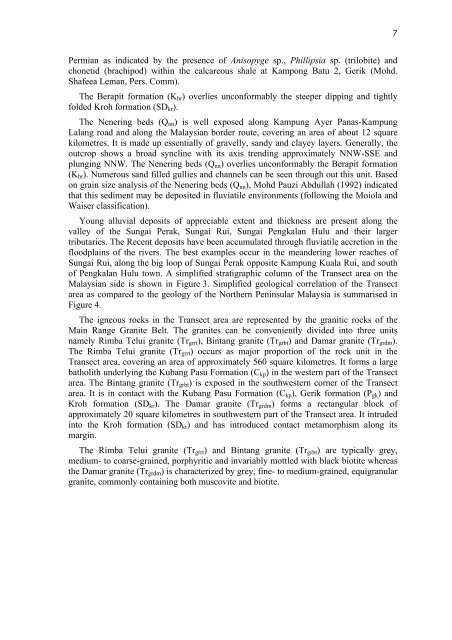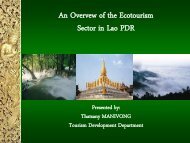GEOLOGY OF THE PENGKALAN HULU-BETONG TRANSECT ...
GEOLOGY OF THE PENGKALAN HULU-BETONG TRANSECT ...
GEOLOGY OF THE PENGKALAN HULU-BETONG TRANSECT ...
Create successful ePaper yourself
Turn your PDF publications into a flip-book with our unique Google optimized e-Paper software.
Permian as indicated by the presence of Anisopyge sp., Phillipsia sp. (trilobite) and<br />
chonetid (brachipod) within the calcareous shale at Kampong Batu 2, Gerik (Mohd.<br />
Shafeea Leman, Pers. Comm).<br />
The Berapit formation (Kbr) overlies unconformably the steeper dipping and tightly<br />
folded Kroh formation (SDkr).<br />
The Nenering beds (Qnn) is well exposed along Kampung Ayer Panas-Kampung<br />
Lalang road and along the Malaysian border route, covering an area of about 12 square<br />
kilometres. It is made up essentially of gravelly, sandy and clayey layers. Generally, the<br />
outcrop shows a broad syncline with its axis trending approximately NNW-SSE and<br />
plunging NNW. The Nenering beds (Qnn) overlies unconformably the Berapit formation<br />
(Kbr). Numerous sand filled gullies and channels can be seen through out this unit. Based<br />
on grain size analysis of the Nenering beds (Qnn), Mohd Pauzi Abdullah (1992) indicated<br />
that this sediment may be deposited in fluviatile environments (following the Moiola and<br />
Waiser classification).<br />
Young alluvial deposits of appreciable extent and thickness are present along the<br />
valley of the Sungai Perak, Sungai Rui, Sungai Pengkalan Hulu and their larger<br />
tributaries. The Recent deposits have been accumulated through fluviatile accretion in the<br />
floodplains of the rivers. The best examples occur in the meandering lower reaches of<br />
Sungai Rui, along the big loop of Sungai Perak opposite Kampung Kuala Rui, and south<br />
of Pengkalan Hulu town. A simplified stratigraphic column of the Transect area on the<br />
Malaysian side is shown in Figure 3. Simplified geological correlation of the Transect<br />
area as compared to the geology of the Northern Peninsular Malaysia is summarised in<br />
Figure 4.<br />
The igneous rocks in the Transect area are represented by the granitic rocks of the<br />
Main Range Granite Belt. The granites can be conveniently divided into three units<br />
namely Rimba Telui granite (Trgrrt), Bintang granite (Trgrbt) and Damar granite (Trgrdm).<br />
The Rimba Telui granite (Trgrrt) occurs as major proportion of the rock unit in the<br />
Transect area, covering an area of approximately 560 square kilometres. It forms a large<br />
batholith underlying the Kubang Pasu Formation (Ckp) in the western part of the Transect<br />
area. The Bintang granite (Trgrbt) is exposed in the southwestern corner of the Transect<br />
area. It is in contact with the Kubang Pasu Formation (Ckp), Gerik formation (Pgk) and<br />
Kroh formation (SDkr). The Damar granite (Trgrdm) forms a rectangular block of<br />
approximately 20 square kilometres in southwestern part of the Transect area. It intruded<br />
into the Kroh formation (SDkr) and has introduced contact metamorphism along its<br />
margin.<br />
The Rimba Telui granite (Trgrrt) and Bintang granite (Trgrbt) are typically grey,<br />
medium- to coarse-grained, porphyritic and invariably mottled with black biotite whereas<br />
the Damar granite (Trgrdm) is characterized by grey, fine- to medium-grained, equigranular<br />
granite, commonly containing both muscovite and biotite.<br />
7



